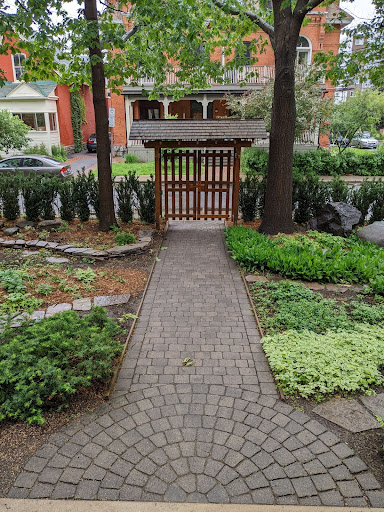
View of path and gate from porch,
Photograph by Ven. Jinmyo Renge sensei

View of path and gate from porch,
Photograph by Ven. Jinmyo Renge sensei
eMirror Vol 26, No. 24
Friday, June 10th
Edited by the Practice Council
The White Wind Zen Community:
An international community practising and teaching Dogen’s Zen since 1985.
All arts have some kinesthetic element but the single kinesthetic art that I can think of is dance. And even so, this is primarily visual for the audience. A dance work requires choreography, performers, costumes, a stage, lighting, sets, music, all of the people who have or are working on this for the performance, and an audience that watches it. In listening to music, which is a presentation of sounds, one uses hearing. In viewing painting or sculpture or ikebana, which is a presentation of sights, one uses seeing. In dance, which is a matter of movement, the audience just sits there watching it. Much of dance involves a kind of storytelling, sometimes so much so that it is more a matter of acting than of dance. This is only natural since dance as a form in itself derived long ago from accompaniment to tales of hunting, war, fortune or misfortune, and romance. As well, much of the story is told through the music, the costume, the sets, the lighting. And this of course is fine but it has little to do with kinesthetics except for that aspect of kinesthetic intelligence that is involved with conveying the story without words. And of course, I do not say this to denigrate dance. Much the contrary. Like many art forms, it is a coming together of many elements and unlike the visual arts such as painting or sculpture, it also appeals to the sense of hearing. Unlike music, it also appeals to the visual sense. Still, sometimes there is something about movement that is conveyed. Sometimes a movement within the dance stirs a bodily response in the watching audience or at least some of them. A thigh muscle might flex or twitch, the breath might be caught or released. Something of the possibilities of their own capacities for movement might be conveyed. Sometimes, in standing and putting on their coats and leaving the theatre a sense of wonder of movement might be carried with the audience.
The ability to move is wonderful. To stand, to turn, to bend, to reach, to let go is wonderful. The sensation of movement, the sensations that flutter throughout the bodymind, the flashing of nerve impulses that allows a hand to arc up through space to meet the other hand in the gesture of gassho is wonderful. For people to recognize this is wonderful.
In the Fukanzazengi, Zen Master Dogen says, “Practice and realization are the deportment of this very bodymind, beyond sight and sound, before thinking and analyzing.”
And in Gabyo he says,
The entire universe with all of its events is only a painted picture. People and all beings arise there and Awakened Ones and Ancestors Wake Up and become what they are through it….You should practise this whole world as a “painted rice cake.” Practise the meaning of this through the bodymind and you will intimately understand the energy of that which moves and that which is moved. If this energy is not manifested, your practice of the Way is still unmanifested. Manifesting this energy is itself how to paint Awakening.
In the light touch of thumb-tip to thumb-tip in Dharmadhatu mudra, you are feeling the sensation of the world.
Ven Anzan Hoshin roshi, concluding Class Three: "Touching the Sensation of the World" in the series "Zen Arts: The Flowering of the Senses", October 1999 Daruma-ki O-sesshin, Dainen-ji.
Fusatsu: June 15th and 29th.
June Two-day Sesshin:
The June two-day sesshin will begin at 8:00 p.m. on Friday, June 10th and will end at 6:00 p.m. on Sunday, June 12th.
Hermitage:
The Roshi is currently in an extended period of "self-isolation" due to underlying health issues until the COVID-19 situation clarifies.
Beginning Instruction in Zen Practice:
For information concerning our Long-distance Training Program, please visit this Web Page: https://wwzc.org/long-distance-training-program
Rev. Chiso anagarika sat her weekly semi-retreat on Tuesday, June 7th at her home in the Berkshires. Aaron Ford sat a half-day retreat on Friday, June 3rd at his home in Calgary, Alberta. Julien Jefferson sat a half-day retreat on Saturday, June 4th at his home in Halifax, Nova Scotia.
If you would like to sit a retreat at home please follow the schedule outlined in this page: https://wwzc.org/retreat-schedule-public-students. After your retreat, please send an email to schedule@wwzc.org to confirm that you sat a retreat and include the duration and location.
Saturday, June 11th to Saturday, June 18th
Saturday, June 11th: "Bodymind of the Way: Zen Master Anzan Hoshin's Commentaries on Eihei Dogen zenji's "Shinjin Gakudo": "Raw Practice " (9 of 17)
Monday, June 13th: “Every Breath You Take” by Ven. Shikai Zuiko o-sensei: “Seeing People of Right Livelihood"(Dharma Talk 93)
Thursday, June 16th: "Stainless" by Ven. Jinmyo Renge sensei
Saturday, June 18th: "Bodymind of the Way: Zen Master Anzan Hoshin's Commentaries on Eihei Dogen zenji's "Shinjin Gakudo": "A Good Morning to Wake Up" (10 of 17)
Associate and general students should continue to follow the recorded Teachings schedule for the sitting you were attending at the monastery, and listen to that during your home practice.
You can access the online Recorded Teachings Library at wwzc.org/recorded-teachings-schedule.
You can also use the streaming site at app.wwzc.org to live stream recordings from the online Library. If you have forgotten your password or need assistance with accessing the recorded Teachings, please email schedule@wwzc.org.
Please note that teisho should be listened to in the correct order and with none missed out as themes, metaphors, questions raised and answered evolve in spirals throughout the series.
While most of the online Recorded Teachings library is password-protected and only accessible to students of the Lineage of Zen Master Anzan Hoshin, a small selection of MP3 recordings of teisho are accessible to the public at wwzc.org/recorded-teachings Additional recordings will be uploaded periodically. MP3 recordings of four recorded teisho by Ven. Anzan Hoshin roshi are currently available:
Dharma Position https://wwzc.org/dharma-position
Eyes See, Ears Hear https://wwzc.org/eyes-see-ears-hear
Embarrassment https://wwzc.org/embarrassment
Ven. Anzan Hoshin roshi's reading of his translation of Eihei Dogen zenji's “Bendowa: A Talk on Exerting the Way”: https://wwzc.org/bendowa-talk-exerting-way

Photograph of Ven. Anzan Hoshin roshi at Daijozan, mid-1980s,
by Ven. Shikai Zuiko sensei
Ven. Anzan Hoshin roshi has recently completed translation work on some shorter texts by Eihei Dogen zenji from the Shobogenzo. The work on these particular texts is based upon the literal translations that he worked on with Joshu Dainen roshi at Hakukaze-ji around 1977-78 followed by many years of putting them down, picking them up, and polishing. Naturally, more essential texts such as Uji, Genjokoan, Shinjin Gakudo and some 40 others were completed first and have been given extensive commentaries by the Roshi. This batch of texts includes Baike: Plum Blossoms, Ryugin: Howling Dragon, and Udonge: The Udumbara Blossoming and many others are nearing completion. Annotation details and successfully conveying them across various document formats are the issue at this point.
Work on Bussho: Buddha Nature, a very long and nuanced text by Dogen zenji, is ongoing.
Roshi is also finishing an update to the Saijo Shingi: The Deportment of Radiance, our manual of monastic training standards which is a supplement to the ancient Eihei Shingi and Keizan Shingi.
by Saigyo ino
Photographs by Jinmyo sensei
Over the weekend of May 28th and 29th, 17 students attended our spring Samu Weekend and completed a wide variety of tasks in the grounds and inside the monastery. In the grounds we completed the installation of a new front border at the sidewalk using pressure treated planks and river-wash stone. This border can now be planted with shade loving plants to complete the work to re-landscape the front hedge area which began with planting of the new Hills Yew hedge in the early spring. Landscaping work was also completed at the side entrance and along the east of the building. More planting and tidying, mulching and watering was done in the grounds over the two days and the snow blower and its housing were put away for the year. A repair was made to the front steps handrail.
Inside the building the large bookcase which was being stored in the Zendo was installed in what will become the guest room next the Shuryo and the Zendo was cleaned and reset ready for sittings. Lots of organisation of books and journals was done in the Shuryo and in the new archiving room on the ground floor, the computer equipment and desks required for the archiving work were installed. The large number of CD's we have of the recorded Teachings was organised and collated so that they can be made available to students for purchase. The basement stairs were repainted.
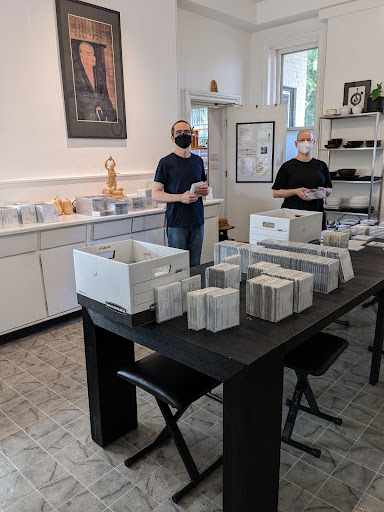
Mishin godo and Leonardo sorting CDs for sale
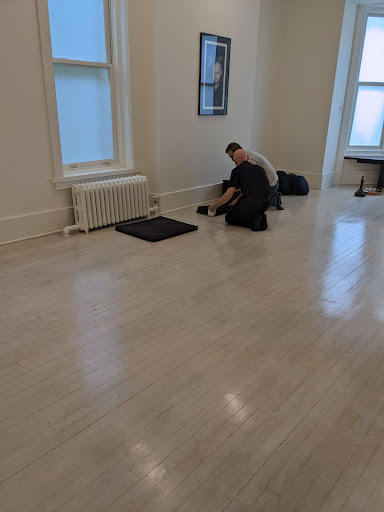
Saigyo Ino and Mario cleaning the Zendo
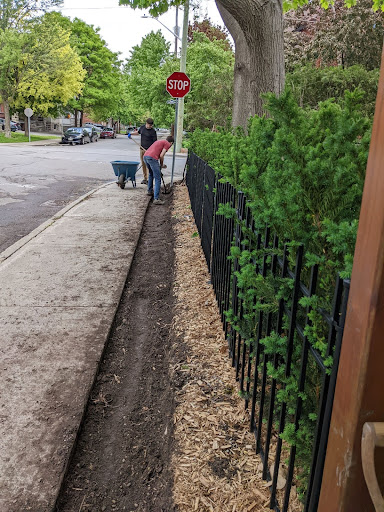
Loic and Ian preparing the border next to the hedge
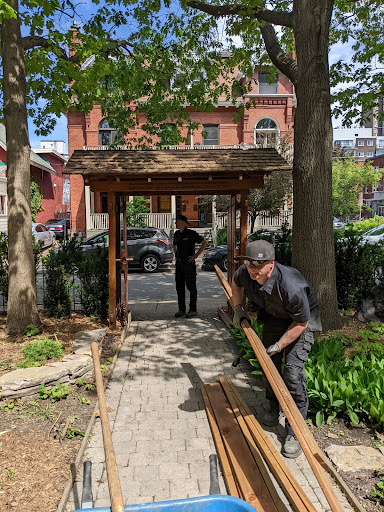
Saigyo Ino and Fushin shuso working on the border for the hedge

Almost finished border (we intend to plant a variety of hostas all along the fence line)

Jesse Steinberg, Artik Chauhan working on the stone pathway
Thank you to Jinmyo sensei for the excellent meals she prepared for students who stayed for samu for the whole day and for keeping a photographic record of the work.
Thank you to the following students who offered their time to assist with maintaining and improving the practice environment:
Mishin godo, Fushin shuso, Leonardo Nobrega, David Gallant, Eric Cyr, Sophia Stevenson, Loïc-Alexandre Ouellette, Ian Richard, Mario Delisle, Rowen Russel, Shigemi Ichino, Sam McFarlane, Jesse Steinburg, Artik Chauhan, Marc Valade and Sydnee Burgess.
Begun by Ven. Shikai Zuiko o-sensei
Finished by Rev. Fushin Comeau shramon following her death

Tao (C ); Dõ (J): A term common in all Chinese thought as the principle of all things or the path. See also "Dõ".
Posted June 10th , 2022. New entries are posted every two weeks.

Dogen zenji taught in the Tenzo kyokun: Instructions for the Tenzo (https://wwzc.org/dharma-text/tenzo-kyokun-instructions-tenzo) that the work of preparing and serving meals is "a matter for realized monks who have the mind of the Way or by senior disciples who have roused the Way-seeking mind." In alignment with this, part of Zen Master Anzan Hoshin's samu for the Community involves personally overseeing the activities of the ancient office of tenzo. Ven. Jinmyo Renge sensei serves as tenzo and Mishin godo and Saigyo ino offer assistance as tenzo-anja. The following meals were prepared for residents on Monday, Tuesday and Thursday evenings.
Monday Yakuseki:
Noodles with garlic sauce (sauteed strips of onion, poblano and cubanelle peppers, mixed with spaghettini noodles in a sauce made from minced garlic and ginger, vegetarian oyster sauce, low sodium shoyu, sambal oelek, sesame oil and a small amount of brown sugar); deep fried tofu cooked with butter and Yeo’s hot chili sauce; gai lan stems and leaves with lime juice.
Tuesday Yakuseki:
Thai white and brown rice; Thai curry with choice of tofu or chicken (the Thai curry was made with Aroy-D coconut milk, red curry paste, lime juice, chopped coriander, chopped Spanish onions, bamboo shoots, baby bok choy, poblano and cubanelle peppers, served with fresh basil and coriander); green cabbage slaw with shredded carrots, daikon and thin strips of red onion seasoned with mayonnaise and yellow Thai curry paste.
Thursday Yakuseki:
Thai white and brown rice; bulgogi tofu (chopped Spanish onion, red bell, cubanelle, and jalapeno peppers, Napa cabbage, pan fried tofu, ginger, bulgogi sauce, shoyu); kimchi mixed with sliced cucumbers, chopped scallions, garlic, shoyu.
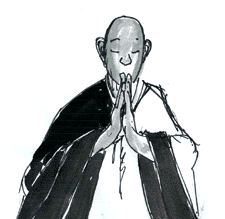
If you would like to thank someone for a contribution they have made, please feel free to send an email to Jinmyo sensei at rengezo@gmail dot com, but be sure to type "eMirror” in the subject line.
From David Gallant:
Thank you to Jinmyo sensei for regular dokusan and for the many meals she prepares for residents each week. Thank you to Fushin shuso for organizing the recent purchase of a powerful vacuum for the third floor after our old unit broke. Thank you to all residents at Dainen-ji for sharing in a little birthday celebration with me on Wednesday evening, and to Mishin godo for picking up a small cake.
From Stacey Loyer:
Thank you to everyone responsible for providing virtual support for students, such as: scheduling and holding telephone practice interviews; reading practice journals; publishing the eMirror; and, making recorded teachings available online. These have been invaluable for me to maintain my practice, especially over the last few years.
From the Office of the Treasurer:
Thank you to Rob Parisien for a donation.
|